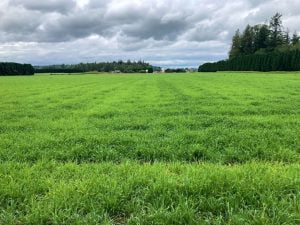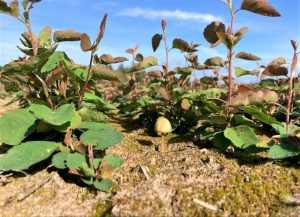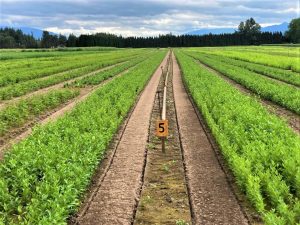Plant Materials Center Update: June 16, 2022

Here are 5 things that you should know about the PMC for June 30, 2022:
Summer Arrived
Spring was cool and damp right up to the first day of summer and thankfully things have warmed up and dried out now that it is officially summer. We have noticed some decreases in growth rates due to the mild spring but that will change now that it is warmer.
The cool weather was more of an issue for some of the local crop farmers. Strawberries are just now being picked which is almost a month behind schedule. Corn is small, cereal crops pale, and they are still planting potatoes so there is not too much to complain about here, except….
Weeds
The weeds got off to a frightful start this year. The mild spring did not deter them whatsoever. That problem was compounded by the PMC getting behind schedule due to a longer than anticipated harvest. That in turn delayed the completion of transplanting. By the time that was wrapped up the weeds were so bad in some places that one could not see the plants growing under them. Fortunately, the weeding crew at the PMC is top notch and it looks like weed management is on schedule. That could change in a day but so far so good.
Seed Collection Season Starts
The 2022 seed collection season has started. The two earliest species to produce ripe seed for the PMC is Red Elderberry (Sambucus racemose) and Osoberry (Oemleria cerasiformis). Dewberry (Rubus ursinus) and Salmonberry (Rubus spectablis) are next. So far wild seed production for the species the PMC grows from seed looks good.
Even more promising are some of the cone crops of a few of our native conifer species. Douglas Fir (Pseudotsuga menziesii) and Western Red Cedar (Thuja plicata) are currently producing masses of cones. When a conifer species produces an unusual quantity of cones that year is know as a mast year and this could be a mast year.
It is still early in the season and there is a lot that can happen to the cones and seeds between now and collection time. If pollination was incomplete the cones could wind up with few viable seeds, insects could get inside the seeds or the trees could drop cones prematurely due to environmental stresses. But right now, things are looking good and if anyone is interested in producing seedlings from local seeds, they might want to consider conducting cone collections. This could be the year for some species in certain regions. The PMC can help with some advice on what to look for before initiating a collection, and how to collect cones and get them processed.
Cover Crops Established
After a field of seedlings are harvested the PMC plants the field in a cover crop of barley to increase organic matter and improve soil tilth. Barley is used because it produces a lot of organic matter relatively quickly. Some of these fields will be fall planted which means that the cover crop is worked into the ground in early August. The barley does show some reduction in growth due to the mild weather so far but that will probably turn around soon.
Irrigation Under Way
There have been a few warm days this year which resulted in the need to irrigate. Fortunately, the PMC has a first-rate irrigation system. This time last year it was being used frequently due to the excessive heat during the Heat Dome. The high on June 29th last year was 108°.
There are 3 irrigation wells which allows for redundancy should a pump fail, which is a potential issue right now. One of the pumps is not producing as much pressure as it should so someone will be brought in to look at it. These wells, pumps, and controls are over 35 years old so problems are not unexpected. A bright spot is that after an unusually wet winter and spring the aquifer is recharged. The static level in the well is probably fairly shallow.
I hope this helps. Please let me know if you have any questions.
Jim Brown
Director of Nursery Operations





